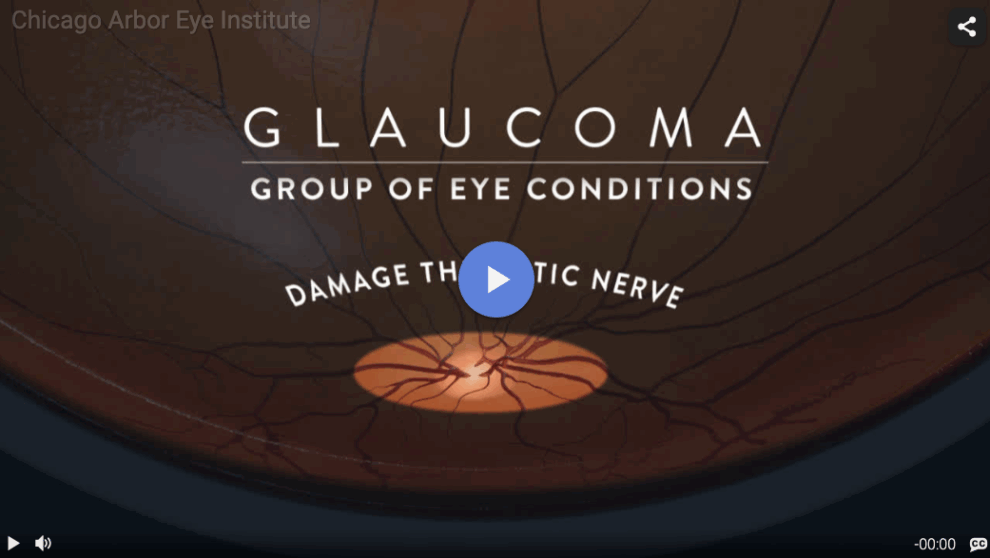Glaucoma

At Chicago Arbor Eye Institute, our dedicated team of glaucoma specialists is committed to preserving your vision through exceptional care. With expertise in the latest techniques and treatment options, our glaucoma specialists provide solutions tailored to your unique needs.
What is Glaucoma?
Glaucoma is a group of eye diseases that damage the optic nerve, which carries visual information from the eye to the brain. This damage is usually caused by abnormally high pressure inside the eye.
It is a leading cause of vision loss, especially in older adults. Glaucoma is often called the “silent thief of sight” because it typically has no noticeable symptoms in the early stage.
For this reason, many people don’t realize they have it until significant vision loss has already occurred. Early detection through regular eye exams is critical to diagnose and treat glaucoma before permanent vision loss happens.
What Causes Glaucoma?
The eye constantly produces fluid called aqueous humor, which normally drains out of the eye at a balanced rate to maintain healthy eye pressure. In glaucoma, the drainage system becomes blocked, or too much fluid is produced.
This causes pressure rise inside the eye, eventually damaging the sensitive optic nerve fibers. Each person’s eyes are unique, so there is no single “normal” eye pressure.
What may be a safe pressure for one person could be high enough to cause glaucoma damage in someone else. However, eye doctors typically look for eye pressure readings in a certain range to ensure the average person is not at risk for optic nerve damage.
Eye pressure is not the only test that eye doctors perform to check for glaucoma. Evaluating glaucoma risk requires looking at many factors beyond just a pressure reading, such as changes in your optic nerve or visual field.
What Are the Symptoms of Glaucoma?
In most cases, glaucoma progresses gradually without causing any pain or vision changes in the early stages. Peripheral (side) vision is usually the first to be affected.
Since this part of the visual field is not typically focused on during the average person’s typical day-to-day activities, changes to this part of vision often goes unnoticed. As the glaucoma progresses, blind spots can develop in the visual field.
If left untreated, glaucoma can lead to tunnel vision and eventually total blindness, including your central vision. The optic nerve damage from glaucoma is irreversible, so any vision loss cannot be restored.
Rarely a severe form called acute angle-closure glaucoma develops suddenly. This is a medical emergency with symptoms like intense eye pain, headache, nausea, and seeing halos around lights.
Immediate treatment is needed for angle-closure glaucoma to prevent rapid, permanent vision loss.

How is Glaucoma Diagnosed?
Diagnosing glaucoma involves a comprehensive eye examination. During this exam, your eye doctor will perform a series of tests to evaluate the health of your eyes and check for signs of glaucoma.
They will measure your eye pressure using a technique called tonometry. A special lens called a gonioscope may be used to inspect the drainage angle inside your eye.
Your eye doctor will also carefully examine your optic nerve for any damage or abnormalities. To assess your peripheral (side) vision, you’ll take a visual field test.
Additional imaging tests, such as optical coherence tomography (OCT), may be performed to provide detailed pictures of your retina and optic nerve. This thorough evaluation helps your Chicago Arbor Eye Institute eye doctor determine if you have glaucoma and how far the condition has progressed.

How is Glaucoma Treated?
While there is no cure for glaucoma, treatment can control it and usually prevent further vision loss. The best approach depends on the specific type of glaucoma and how far it has progressed.
Treatment focuses on lowering eye pressure to stop optic nerve damage.
Medications
Prescription eye drops are the most common initial treatment. They work by either decreasing fluid production or improving drainage.
Some people may need to use more than one type of drop. Medications can have side effects and may lose effectiveness over time.
Laser Procedures
Laser therapies can increase fluid drainage to lower eye pressure:
Selective Laser Trabeculoplasty (SLT)
This in-office procedure is used for open-angle glaucoma. It stimulates drainage cells to work more efficiently.
Laser Peripheral Iridotomy (LPI)
Used for angle-closure glaucoma, LPI creates a small hole in the iris to improve drainage.
Micropulse Diode Laser Cyclophotocoagulation (MPDLC)
This advanced procedure is primarily used for refractory glaucoma cases that haven’t responded well to other treatments. This treatment uses short pulses of laser energy to target the ciliary body, which produces fluid in the eye.
By reducing fluid production, it helps lower intraocular pressure.
These treatments are office-based procedures that have shown great effectiveness in assisting glaucoma control.
Minimally Invasive Glaucoma Surgery (MIGS)
These minimally invasive techniques, often combined with cataract surgery, use tiny incisions and devices to lower eye pressure with less risk than traditional surgery. Some of the MIGS procedures we offer include:
iStent Inject
This procedure involves the placement of two tiny stents in the eye’s drainage system to improve fluid outflow and lower eye pressure.
Hydrus Microstent
A small, flexible device is inserted into the eye’s drainage canal to enhance fluid drainage and reduce eye pressure.
iTrack Canaloplasty
This procedure uses a microcatheter to enlarge the eye’s natural drainage canal, improving fluid outflow and lowering eye pressure.
Omni Surgical System
This device combines two procedures, canaloplasty and trabeculotomy, to improve fluid drainage and reduce eye pressure.
Goniotomy
This procedure involves making a small incision in the eye’s drainage angle to create a new pathway for fluid outflow.
iDose
A tiny, sustained-release implant that continuously delivers medication to lower eye pressure over an extended period.
Durysta
A biodegradable implant that slowly releases medication to reduce eye pressure for several months.
At Chicago Arbor Eye Institute, Dr. Korey specializes in MIGS procedures, with a particular focus on goniotomy as his standard approach. These minimally invasive techniques are typically performed as office-based procedures and have proven highly effective in assisting with glaucoma control.
Chicago Arbor Eye Institute was also a site for the FDA clinical trials of iStent Inject, iStent Infinite, and iDose. We are currently participating in the NIH COAST SLT trial to advance glaucoma treatment options.
Traditional Glaucoma Surgery
If medications and laser procedures are not enough, surgery may be needed to create a new drainage channel. Beyond MIGS procedures, our glaucoma surgeons also offer:
Trabeculectomy
This conventional surgery creates a small flap in the sclera (white of the eye) to form a new drainage pathway.
Drainage Implant
A tiny tube shunt can be surgically inserted to drain fluid out of the eye if other methods are not successful.
Glaucoma is a lifelong condition that requires ongoing monitoring and treatment to preserve vision. Most people with glaucoma are able to maintain good vision with proper care.
Early diagnosis and treatment provide the best chance of minimizing vision loss.







